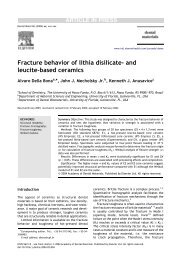Microtensile bond strength of a filled vs unfilled adhesive to dentin ...
Microtensile bond strength of a filled vs unfilled adhesive to dentin ...
Microtensile bond strength of a filled vs unfilled adhesive to dentin ...
Create successful ePaper yourself
Turn your PDF publications into a flip-book with our unique Google optimized e-Paper software.
286<br />
Table 3 Mean microtensile <strong>bond</strong> <strong>strength</strong> <strong>to</strong> <strong>dentin</strong> using One-Step Plus and One-Step <strong>adhesive</strong>s with <strong>to</strong>tal and<br />
self-etch technique.<br />
Type <strong>of</strong> <strong>adhesive</strong> Technique MeanGsd<br />
Filled (One-Step Plus) Total-etch 38.8G12.2 a (nZ20)<br />
Filled (One-Step Plus) Self-etch 22.4G4 b (nZ20)<br />
Un<strong>filled</strong> (One-Step) Total-etch 33.9G8.5 a (nZ20)<br />
Un<strong>filled</strong> (One-Step) Self-etch 26.4G7.5 b (nZ20)<br />
Different superscript letters indicate significant differences by two-way ANOVA and post hoc Tukey’s test (p!0.05).<br />
Japan) and polished using wet silicon carbide<br />
abrasive papers and diamond pastes <strong>of</strong> decreasing<br />
abrasiveness <strong>to</strong> 0,25 mm (DP-Paste, P, Streuers<br />
A/S, Copenhagen, Denmark). They were then<br />
subjected <strong>to</strong> argon ion etching (EIS-1E, Elionix<br />
Ltd, Tokyo, Japan) for 5 min with a constant<br />
voltage <strong>of</strong> 1 kV and ion current density <strong>of</strong><br />
0.2 mA/cm 2 , with the ion beam directed 908 <strong>to</strong><br />
the specimen surface, 22 gold-sputter coated and<br />
observed using a scanning electron microscope<br />
(JSM 5400; JEOL Ltd, Tokyo, Japan).<br />
Four additional non-carious third molars (one<br />
per group) were used for SEM examination <strong>of</strong> the<br />
resin-<strong>dentin</strong> interfaces <strong>to</strong> serial acid-base treatment<br />
resistance. The specimens were prepared as<br />
in the above mentioned manner and polished.<br />
They were then subjected <strong>to</strong> 10% phosphoric acid<br />
treatment for 3–5 s 23 followed by 5% sodium<br />
hypochloride immersion for 5 min. 24 After being<br />
extensively rinsed, the specimens were dried<br />
gold-sputter coated and observed using a scanning<br />
electron microscope (JSM 6335F; JEOL Ltd,<br />
Tokyo, Japan).<br />
Results<br />
Two-way ANOVA showed that the mTBS results<br />
(Table 3) were significantly influenced by the<br />
technique (pZ0.000) but not by the type <strong>of</strong><br />
<strong>adhesive</strong> (pZ0.836). The interaction <strong>of</strong> these two<br />
fac<strong>to</strong>rs was significant (pZ0.025), indicating that<br />
the differences that existed between two techniques<br />
(<strong>to</strong>tal-etch and self-etch) were not dependent<br />
on the type <strong>of</strong> <strong>adhesive</strong>.<br />
Multiple comparisons (post hoc Tukey’s test)<br />
revealed that <strong>to</strong>tal-etch technique exhibited significantly<br />
higher <strong>bond</strong> <strong>strength</strong> values than the selfetch<br />
technique with both <strong>filled</strong> (pZ0.000) and<br />
un<strong>filled</strong> <strong>adhesive</strong>s (pZ0.031). The mTBS <strong>of</strong> the <strong>filled</strong><br />
<strong>adhesive</strong> One-Step Plus (38.8G12.2 MPa) and the<br />
un<strong>filled</strong> <strong>adhesive</strong> One-Step (33.9G8.5 MPa) were<br />
not significantly different when they were used with<br />
the <strong>to</strong>tal etch (pZ0.298), and with the self-etch<br />
E. Can Say et al.<br />
technique (22.4G4.0 and 26.4G7.5 MPa, respectively)<br />
(pZ0.459).<br />
SEM observations <strong>of</strong> the resin-<strong>dentin</strong> interfaces<br />
revealed that the thickness <strong>of</strong> the hybrid layers<br />
Figure 1 (A) Scanning electron micrograph <strong>of</strong> the resin–<br />
<strong>dentin</strong> interface <strong>bond</strong>ed with One-Step Plus with <strong>to</strong>taletch<br />
technique after argon ion etching. Hybrid layer was<br />
3 mm thick. Fillers were uniformly dispersed in the<br />
<strong>adhesive</strong> layer and were evident around the tubuler<br />
orifices and in the tubules (arrow). c, composite; fa, <strong>filled</strong><br />
<strong>adhesive</strong>; h, hybrid layer; d, <strong>dentin</strong>. (B) Scanning electron<br />
micrograph <strong>of</strong> the resin–<strong>dentin</strong> interface <strong>bond</strong>ed with<br />
One-Step Plus with <strong>to</strong>tal-etch technique subjected <strong>to</strong><br />
sequential acid–base treatment. Hybrid layer was<br />
approximately 3 mm thick and resin-tags (arrow) penetrating<br />
in<strong>to</strong> <strong>dentin</strong>al tubules were clearly observed.<br />
Adhesive layer was 17 mm thick. c, composite; fa, <strong>filled</strong><br />
<strong>adhesive</strong>; h, hybrid layer; d, <strong>dentin</strong>.
















